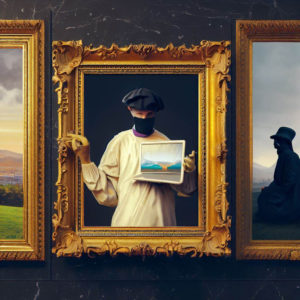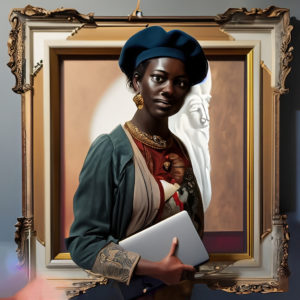Generative AI Art is a form of art that uses artificial intelligence to create images or sounds from a given prompt. It is a way of exploring the possibilities of creativity and imagination beyond human limitations. Generative AI Art can be seen as a collaboration between humans and machines, where humans provide the inspiration and guidance, and machines provide the execution and variation.
Some examples of generative AI art tools are DALL-E by OpenAI, Microsoft Designer’s image generator, Bing Image Creator, Deep Art, Artbreeder, and AI Painter . These tools allow users to generate realistic or abstract images from text descriptions, photos, drawings, or combinations of them, within seconds. Users can experiment with different concepts, attributes, and styles, and generate images and, using some of these tools, can also modify and customize the generated images to suit their preferences and purposes. I think of generative AI Art as “painting or photographing or creating with words”.
Generative AI Art has many benefits for artists and non-artists alike. It can help them:
– Express themselves creatively in new and innovative ways
– Discover new styles, forms, and concepts that they might not have thought of before
– Experiment with different media and techniques without the need for expensive equipment or materials
– Learn from the feedback and suggestions of the AI systems
– Have fun and enjoy the process of creation
Is it “Real Art”? This is a question *I* can’t answer. Generative AI art is a process art that uses artificial intelligence to create images from text, sketches, or other inputs. It is based on generative models, such as GANs (Generative Adversarial Networks), that can learn from large datasets of real art created by real artists and produce novel and realistic images that match the given description or style.
However, generative AI art also raises some ethical and legal questions about the use of data and the impact on the livelihoods and integrity of real artists. Some of the issues are:
– Originality and creativity: Is generative AI art original and creative, or is it merely copying and remixing existing art? How can we evaluate the quality and value of generative AI art? Who deserves the credit and recognition for the generated images?
– Data ownership and consent: Who owns the data that is used to train the generative models? Do the original artists give their consent for their work to be used as input for generative AI art? How can the data be protected from misuse or theft?
– Competition and compensation: Is generative AI art a threat to the livelihoods of real artists who spend time and effort to create their work? How can real artists compete with generative AI art that can produce images faster and cheaper? How can real artists be compensated for their contribution to the data that is used by generative AI art?
These are some of the questions that need to be addressed as generative AI art becomes more popular and accessible. Generative AI art has the potential to expand the boundaries of human creativity and expression, but it also poses some challenges and risks that need to be considered and regulated.
There are many who believe that Generative AI Art is not a threat to human creativity, but rather is an opportunity to enhance it. And they believe it is a way of expanding the horizons of art and opening new doors for artistic expression.




